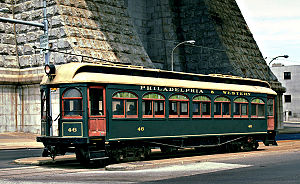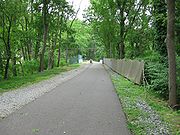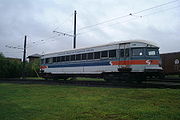
Philadelphia and Western Railroad
Encyclopedia

United States
The United States of America is a federal constitutional republic comprising fifty states and a federal district...
city of Philadelphia
Philadelphia, Pennsylvania
Philadelphia is the largest city in the Commonwealth of Pennsylvania and the county seat of Philadelphia County, with which it is coterminous. The city is located in the Northeastern United States along the Delaware and Schuylkill rivers. It is the fifth-most-populous city in the United States,...
, Pennsylvania
Pennsylvania
The Commonwealth of Pennsylvania is a U.S. state that is located in the Northeastern and Mid-Atlantic regions of the United States. The state borders Delaware and Maryland to the south, West Virginia to the southwest, Ohio to the west, New York and Ontario, Canada, to the north, and New Jersey to...
. One of its lines is now SEPTA's
Southeastern Pennsylvania Transportation Authority
The Southeastern Pennsylvania Transportation Authority is a metropolitan transportation authority that operates various forms of public transit—bus, subway and elevated rail, commuter rail, light rail, and electric trolley bus—that serve 3.9 million people in and around Philadelphia,...
R100 Norristown High Speed Line
Norristown High Speed Line
The Norristown High Speed Line is an interurban line system operated between Upper Darby and Norristown, Pennsylvania, USA by SEPTA...
; the other has been abandoned. Part of the abandoned line within Radnor Township
Radnor Township, Pennsylvania
Radnor Township is a township in Delaware County, Pennsylvania, United States. As of the 2000 census, the township population was 30,878. Radnor Township lies along the Main Line, a collection of highly affluent Philadelphia suburbs....
is now the P&W Trail, a multi-use path.
Lines

69th Street Terminal
69th Street Transportation Center is a SEPTA terminal in Upper Darby, Pennsylvania. It is also the southwestern terminus of Philadelphia's EL, the Market-Frankford Line ....
just west of the Philadelphia city line, west and north to Norristown
Norristown, Pennsylvania
Norristown is a municipality in Montgomery County, Pennsylvania, northwest of the city limits of Philadelphia, on the Schuylkill River. The population was 34,324 as of the 2010 census. It is the county seat of Montgomery County...
, splitting from the original main line at Villanova Junction. Formerly, the P&W's main line went west to a terminus just east of Sugartown Road in Strafford
Strafford, Pennsylvania
Strafford is an unincorporated community in the southeastern part of the U.S. state of Pennsylvania, located partly in Tredyffrin Township, Chester County, and partly in Radnor Township, Delaware County. It is served by its own stop on the SEPTA Paoli/Thorndale Line regional rail train. It is also...
, then later, another .47 mile further, on an extension providing transfer to the PRR Strafford station
Strafford (SEPTA station)
Strafford Station is a commuter rail station located in the western suburbs of Philadelphia atOld Eagle School Road and Crestline Road, Strafford, Pennsylvania. It is served by most Paoli/Thorndale Line trains....
and a transfer track for freight trains. The Strafford Branch was abandoned in 1956; today, the P&W Trail uses its old right-of-way from Radnor-Chester Road to Old Sugartown Road. Up until 1951, the P&W tracks connected with the Lehigh Valley Transit Company's Liberty Bell Route
Liberty Bell Trail
The Liberty Bell Trail is a suburban rail trail under construction in southeastern Pennsylvania.When complete it will cover in suburban southeastern Pennsylvania, traveling from East Norriton Township in Montgomery County to Quakertown in Bucks County....
at Norristown, providing service straight through from Upper Darby to Allentown
Allentown, Pennsylvania
Allentown is a city located in Lehigh County, Pennsylvania, in the United States. It is Pennsylvania's third most populous city, after Philadelphia and Pittsburgh, and the 215th largest city in the United States. As of the 2010 census, the city had a total population of 118,032 and is currently...
.
Interstate Commerce Commission
Interstate Commerce Commission
The Interstate Commerce Commission was a regulatory body in the United States created by the Interstate Commerce Act of 1887. The agency's original purpose was to regulate railroads to ensure fair rates, to eliminate rate discrimination, and to regulate other aspects of common carriers, including...
valuation reports indicate that the railroad had interchange connections to the Pennsylvania Railroad
Pennsylvania Railroad
The Pennsylvania Railroad was an American Class I railroad, founded in 1846. Commonly referred to as the "Pennsy", the PRR was headquartered in Philadelphia, Pennsylvania....
at Millbourne Mills
Millbourne Mills, Pennsylvania
Millbourne Mills was a flour mill owned by the Sellers family in Upper Darby Township, Pennsylvania, U.S.A., as well as the name of a former railroad station located there. The Pennsylvania Railroad's Cardington Branch ended there, where interchange was made with the Philadelphia and Western...
, Strafford
Strafford, Pennsylvania
Strafford is an unincorporated community in the southeastern part of the U.S. state of Pennsylvania, located partly in Tredyffrin Township, Chester County, and partly in Radnor Township, Delaware County. It is served by its own stop on the SEPTA Paoli/Thorndale Line regional rail train. It is also...
and Swedeland.
The line was built as a double-track third rail line. Most structures on the line were designed to ultimately accommodate four tracks, but the added tracks were never built. The quality of the line was quite high, with no at-grade crossings, 2½% maximum grade, stone ballast, block signals, and 85 pound rail. The Norristown Branch, which opened on December 12, 1912, while only 6½ miles long, represented a significant construction challenge due to the high standards maintained on the line's design. The line had to cross 12 highways, the main line of the Pennsylvania Railroad at Radnor, and ended in a single track steel bridge 3,800 feet long into Norristown. Some 400,000 yard of earth, 200,000 yards of stone, and 25,000 yards of masonry, and 2,700 tons of steel were used in its construction.
History


York, Pennsylvania
York, known as the White Rose City , is a city located in York County, Pennsylvania, United States which is in the South Central region of the state. The population within the city limits was 43,718 at the 2010 census, which was a 7.0% increase from the 2000 count of 40,862...
. The WM connected at Connellsville with the Pittsburgh & West Virginia, which connected at Pittsburgh with the Wabash, which in turn connected with the Missouri Pacific, then the Denver & Rio Grande Western, then finally the Western Pacific to form a coast-to-coast railroad. This was a George and Jay Gould
Jay Gould
Jason "Jay" Gould was a leading American railroad developer and speculator. He has long been vilified as an archetypal robber baron, whose successes made him the ninth richest American in history. Condé Nast Portfolio ranked Gould as the 8th worst American CEO of all time...
enterprise; the Goulds were often rumored to have a stake in the P&W, though they publicly denied it.
The first train ran from 69th Street to Strafford on May 22, 1907. On June 6, 1907, the company was reorganizing because it had defaulted on the payment of first mortgage bonds it had issued. The company was sold at public sale by the bond trustee, the Trust Company of North America for $1,000,000 to the Sheldon Syndicate of New York, which was the original owner of the company. The reorganized company had a capital stock of $4,000,000, consisting of $3,400,000 of common stock and $600,000 of 5% preferred stock. The planned extension to Parkesburg
Parkesburg, Pennsylvania
Parkesburg is a borough in Chester County, Pennsylvania, United States. The population was 3,593 at the 2010 census. The Zip code is 19365.-History:...
and York was officially abandoned on March 22, 1912; an alternate extension to the PRR main line in Strafford opened on October 11, 1911. The Norristown Branch opened on December 12, 1912.
The company experienced financial difficulties throughout much of its existence. As noted above it defaulted on its bonds and was reorganized 5 years after founding. In 1916 Moody's rated the company's 50 year Gold First Mortgage Bonds due 1960 as "E," meaning there was "uncertain security as to principal... and a margin of safety over interest as small." The company was again reorganized as the Philadelphia and Western Railroad in 1946. It was sold to the Philadelphia Suburban Transportation Company in 1954; PST was nicknamed the Red Arrow Lines, and merged into SEPTA
Southeastern Pennsylvania Transportation Authority
The Southeastern Pennsylvania Transportation Authority is a metropolitan transportation authority that operates various forms of public transit—bus, subway and elevated rail, commuter rail, light rail, and electric trolley bus—that serve 3.9 million people in and around Philadelphia,...
in 1970.
The P&W once operated local freight trains to various industries along its line until 1970, when the Merion Golf Course stopped its deliveries of sand and other materials. With freight no longer running, the line no longer required FRA control. It was then disconnected from its last interchange, isolating the line from the outside world and then immediately converted from a railroad to a more cost-effective trolley-type operation and continues to operate as such today. Service is currently provided by a fleet of 26 N-5 Light-Rail Vehicles that feature AC-induction propulsion, steerable axles, very large windows, comfortable seating, and are capable of 80 MPH. They were built by ABB Traction in 1990 with their stainless steel bodies being built by SOREFAME which is a Portuguese Budd Company (Philadelphia) licensee.
The last train ran on the Strafford Branch on March 23, 1956. Service is still provided on the Norristown line today. Ground was broken for the P&W Trail on June 10, 2004, and it opened in January 2005.
Equipment
The first cars built for the P&W never ran on the P&W, since the cars were completed before the line was ready to open. Twenty-two wooden electric multiple-unit passenger cars and 2 full-baggage-configured MU's were built for the P&W by the St. Louis Car Co. in 1906. However, due to the San Francisco earthquake 12 of them went to the United Railroads of San Francisco, 4 went to the Sacramento Northern Railroad, and the remainder went to the Erie RailroadErie Railroad
The Erie Railroad was a railroad that operated in New York State, New Jersey, Pennsylvania, Ohio, Indiana, and Illinois, originally connecting New York City with Lake Erie...
Rochester-Mt. Morris Branch, where they were modified and rewired for overhead AC operation. The 12 cars that went to URSF had their bulkhead doors sealed and their MU capabilities removed, operating strictly as single-units. The 4 SN cars were converted into motorized combination baggage/passenger cars and used on the Woodland Branch. The two baggage cars were accepted by the P&W, where they were turned into line-maintenance cars. Finally in 1907, 22 wooden passenger cars, almost identical to the original order, arrived on P&W property. They were originally equipped with retangular-shaped bow collectors, which were later replaced with trolley poles for use in the carbarn area in addition to third rail shoes. Of these cars, No. 46 survives, along with line car No. 401 from the original order; both of which are preserved at the Electric City Trolley Museum in Scranton, PA. Prior to the move to Scranton, they ran as a two-car train while in operation at the Philadelphia Waterfront every Christmas season for many years as the "Santa Train," with No. 401 operating as Santa's workshop and No. 46 used for the passengers.
One type of vehicle used for this line were two 4-unit articulated train sets called Liberty Liners, which were originally the Chicago North Shore and Milwaukee Railroad's
Chicago North Shore and Milwaukee Railroad
The Chicago North Shore and Milwaukee Railroad, often called the North Shore Line, was an interurban railroad line that operated between Chicago, Illinois, and Milwaukee, Wisconsin, until its abandonment in 1963.- Early history :...
Electroliner
Electroliner
The Electroliners were a pair of electric passenger train sets operated by the Chicago North Shore and Milwaukee Railroad, which ran between Chicago, Illinois, and Milwaukee, Wisconsin. These streamlined electric multiple unit interurban trains were built by St. Louis Car Company in 1941. Each...
s. These shovel-nosed high-speed trains featured a bar car and were capable of speeds exceeding 100 mph. They were built by the St. Louis Car Co. in 1941. The Philadelphia Suburban Transportation Company bought both of these trains in 1963. PST removed their trolley poles and replaced their original gravity-type over-running third rail shoes with paddle-type shoes. They were repainted into Red Arrow's color scheme and run in rush hour service with the bar serving continental breakfast in the morning and serving snacks and spirits in the afternoon. They were retired in 1977 due to excessive power consumption plus their excessive weight was just too much for the old jointed rail. As of 2006 they were in museums: one, restored to its original Electroliner appearance, at the Illinois Railway Museum
Illinois Railway Museum
The Illinois Railway Museum is the largest railroad museum in the United States and is located in Union, Illinois, northwest of Chicago...
, and the other at the Rockhill Trolley Museum
Rockhill Trolley Museum
The Rockhill Trolley Museum is located at 430 Meadow Street, Rockhill Furnace, Pennsylvania, north of the Pennsylvania Turnpike and south of US 22, the William Penn Highway....
.

A third and older type was the "Strafford Car," built between 1924 and 1929. The last Strafford Car was retired on March 30, 1990. These MU's originally had bulkhead doors to permit passengers to walk from car to car, high-mounted headlights, trolley poles, and vestibule steps. The bulkhead doors, vestibule steps, and trolley poles were later removed and headlights relocated to below the windshield to make them more aerodynamic and their motors were rewired from 60 to 100 HP, increasing their top speed from 45 to 70 MPH, making them easier to keep up with the newer Bullet trains. By this time the overhead wire in the carbarn area was replaced with extension wire which attached to the third rail shoes to move the MU equipment.
Three other Strafford-type cars, called the 50-series, were purchased from Brill in 1920. They were wider and longer than the later Straffords and never had vestibule steps. They were never rebuilt so with their top speed still only 45 MPH, they had to be used strictly in rush hour short-turn service so they wouldn't get in the way of the other much faster trains. They were finally scrapped in 1952.
Many, widely varied proposals were made to get new equipment for the P&W line but were never carried out. In 1964 a 65-ft. long, high-platform Budd Silverliner-type MU was proposed. There has been much speculation that these cars were actually under construction at Budd when the order was cancelled and the cars became the Rail Diesel Cars that were later sold to Brazil for use on their narrow-gauge mountain-climbing lines; these cars still run today. Then in the late 1970s it was proposed to add-on to the order for the Broad St. Subway cars from Kawasaki with a modified door arrangement. In 1982 a proposal was made to make the line into a wide-gauge, overhead wire, low-platform trolley line which would become connected with the Media and Sharon Hill lines at 69th St. Then a compromise proposal was made for a modified Kawasaki LRV with high-platform doors and standard railroad-gauge trucks. These cars would have looked similar to PCC streetcars with their single, centered headlight and two-piece windshield. Eventually by the late 1980s the order was finally placed for the current fleet of N-5 cars.
Further reading
- DeGraw, Ronald (2007). Bulletin 140, Pig & Whistle: The Story of the Philadelphia & Western Railway. Chicago: Central Electric Railfans' Association. ISBN 978-0915348404

